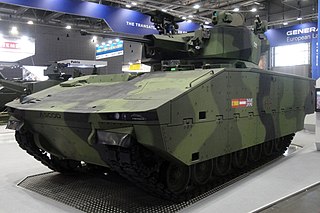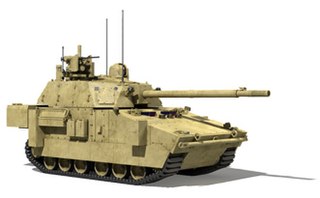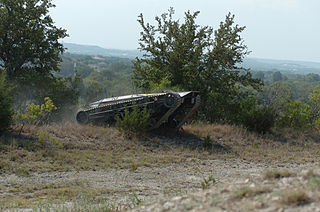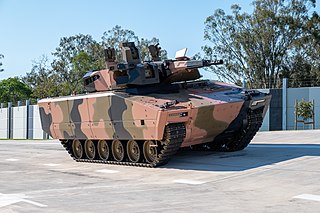Related Research Articles

The M1 Abrams is a third-generation American main battle tank designed by Chrysler Defense and named for General Creighton Abrams. Conceived for modern armored ground warfare and now one of the heaviest tanks in service at nearly 68 short tons, it introduced several innovative features, including a multifuel turbine engine, sophisticated Chobham composite armor, a computer fire control system, separate ammunition storage in a blow-out compartment, and NBC protection for crew safety. Initial models of the M1 were armed with a licensed-produced 105 mm Royal Ordnance L7 gun, while later variants feature a licensed Rheinmetall 120 mm L/44.

The Bradley Fighting Vehicle (BFV) is a tracked fighting vehicle platform of the United States manufactured by BAE Systems Land & Armaments, formerly United Defense. It was named after U.S. General Omar Bradley.

The ICV Stryker is a family of eight-wheeled armored fighting vehicles derived from the Canadian LAV III. Stryker vehicles are produced by General Dynamics Land Systems for the United States Army. It has 4-wheel drive (8×4) and can be switched to all-wheel drive (8×8).

Future Combat Systems (FCS) was the United States Army's principal modernization program from 2003 to early 2009. Formally launched in 2003, FCS was envisioned to create new brigades equipped with new manned and unmanned vehicles linked by an unprecedented fast and flexible battlefield network. The U.S. Army claimed it was their "most ambitious and far-reaching modernization" program since World War II. Between 1995 and 2009, $32 billion was expended on programs such as this, with little to show for it.

The ASCOD armoured fighting vehicle family is the product of a cooperation agreement between Austrian Steyr-Daimler-Puch AG and Spanish General Dynamics Santa Bárbara Sistemas. The ASCOD family includes the LT 105, a light tank equipped with a 105 mm gun, a SAM launcher, an anti-tank missile launcher, mortar carrier, R&R vehicle, Command & Control vehicle, ambulance, artillery observer, and the AIFV model. In Spanish service, the vehicle is called "Pizarro", while the Austrian version is called "Ulan".

The Puma is a German infantry fighting vehicle (IFV) designed to replace the aging Marder IFVs currently in service with the German Army. Production of the first batch of 350 vehicles began in 2010 and is scheduled for completion by the third quarter of 2020. A second batch of 210 Pumas has received funding. Mass production began on 6 July 2009. The companies responsible for this project are Krauss-Maffei Wegmann and Rheinmetall Landsysteme, who created a joint venture in the form of Projekt System Management GmbH (PSM). The Puma is one of the world's best-protected IFVs, while still having a high power-to-weight ratio. SAIC offered a derivative of the Puma as its contender in the now cancelled American GCV Infantry Fighting Vehicle program.
A program executive officer, or PEO, is one of a few key individuals in the United States military acquisition process. As can be seen from the examples below, a program executive officer may be responsible for a specific program, or for an entire portfolio of similar programs.

The Future Combat Systems Manned Ground Vehicles (MGV) was a family of lighter and more transportable ground vehicles developed by BAE Systems Inc and General Dynamics as part of the United States Army's Future Combat Systems (FCS) program. The ground vehicles were to be based on a common tracked vehicle chassis. The MGV program was superseded by the Ground Combat Vehicle which has also been cancelled.

The Ground Combat Vehicle (GCV) was the United States Army's replacement program for armored fighting vehicles in Armored and Stryker brigade combat teams. The GCV was organized under the Follow On Incremental Capabilities Package of the BCT Modernization program. The first variant of the vehicle was to be prototyped in 2015 and fielded by 2017. It replaced the canceled Future Combat Systems, manned ground vehicles program. The Ground Combat Vehicle program was cancelled in February 2014. Its replacement was Next generation combat vehicle.

The Ripsaw is a developmental unmanned ground combat vehicle designed and built by Howe & Howe Technologies for evaluation by the United States Army. Howe & Howe Technologies was purchased by Textron Systems in December 2019.

The Ground Combat Infantry Fighting Vehicle was an infantry fighting vehicle being developed for the U.S. Army. The program originated as the lead vehicle of the U.S. Army's Ground Combat Vehicle program coordinated by TACOM and spawned a parallel program coordinated by DARPA. The purpose of the program was to replace existing armored personnel carriers and infantry fighting vehicles in U.S. Army service. The DARPA project aimed to have the vehicle designed by 2015. Derivatives of the vehicle based on a common chassis—such as tanks and ambulances—were expected to be manufactured. It replaced the previous attempt at a next-generation infantry transport, the XM1206 Infantry Carrier Vehicle. The Ground Combat Vehicle program was cancelled in February 2014.

The M2 Bradley, or Bradley IFV, is an American infantry fighting vehicle that is a member of the Bradley Fighting Vehicle family. It is manufactured by BAE Systems Land & Armaments, which was formerly United Defense.
Quick Kill is an active protection system (APS) designed to destroy incoming anti-tank missiles, rockets, and grenades. The Quick Kill system is designed and produced by Raytheon for the U.S. Army. The Quick Kill system was part of the United States Army's Future Combat Systems.

The Armored Multi-Purpose Vehicle (AMPV) is a U.S. Army program to replace the M113 armored personnel carrier and family of vehicles. A contract for the Engineering, Manufacturing, and Development (EMD) phase was awarded to BAE Systems in December 2014. As of 2015 the program was scheduled to deliver 2,897 vehicles at a total cost of $10.723 billion, or $3.7 million per vehicle. The first AMPV prototype was rolled out on 15 December 2016, and the first production vehicles began rolling out in September 2020.

The Ajax, formerly known as the Scout SV, is a family of armoured fighting vehicles being developed by General Dynamics UK for the British Army.

The Lynx is a German armoured fighting vehicle developed by Rheinmetall Landsysteme. The Lynx, configured as a KF31 infantry fighting vehicle (IFV), was unveiled publicly at the Eurosatory defence exhibition on June 14, 2016. The KF41 variant was unveiled publicly at the Eurosatory defence exhibition on June 12, 2018. According to Rheinmetall, the Lynx family of tracked armoured vehicles is at the forefront of a new trend in IFV design toward armoured vehicles with lower unit and through-life costs and reduced complexity. One of the key principles of the Lynx concept is the integration of proven sub-systems with a high technology readiness level to reduce development time, cost and technical risk.

United States Army Futures Command (AFC) is a United States Army command aimed at modernizing the Army. It currently focuses on six priorities: 1— long-range precision fires, 2— next-generation combat vehicle, 3— future vertical lift platforms, 4— a mobile & expeditionary Army network, 5— air & missile defense capabilities, and 6— soldier lethality. AFC's cross-functional teams (CFTs) are Futures Command's vehicle for sustainable reform of the acquisition process for the future.

The Main Ground Combat System (MGCS) is a project by France and Germany since 2012 to replace their currently deployed Leclerc and Leopard 2 main battle tanks (MBTs). In 2016, the program was in the concept phase which was projected to be completed by 2017.
The General Dynamics Griffin is a series of armoured fighting vehicles under development by General Dynamics Land Systems (GDLS) for the United States Army. The Griffin is a derivative of ASCOD family of AFVs, which was also designed by GDLS.

Overmatch is a concept in modern military thinking which prizes having overwhelming advantages over an adversary to a more significant margin than in traditional warfare. It is related to military superiority. Overmatch uses a military force's "capabilities or unique tactics" to compel the opposing forces to stop using their own equipment or tactics, as doing so would lead to their own defeat or destruction. By fielding the right mix of capabilities, the commander can present multiple dilemmas to the enemy, thus compelling the enemy to withdraw.
References
- ↑ Feickert, Andrew. "The Army's Optionally Manned Fighting Vehicle (OMFV) Program: Background and Issues for Congress" (PDF). Federation of American Scientists. Congressional Research Service. Retrieved 23 September 2020.
- ↑ Judson, Jen (2017-10-10). "Next-Gen Combat Vehicle prototyping kicks off". Defense News. Retrieved 2020-01-24.
- ↑ "Army looking for Optionally-Manned Fighting Vehicle". www.army.mil. Retrieved 2020-01-24.
- ↑ Judson, Jen (2019-04-01). "Army drops request for proposals to build next-gen combat vehicle prototypes". Defense News. Retrieved 2020-01-24.
- ↑ Judson, Jen (2019-12-23). "Congress injects millions of dollars to advance next-gen combat vehicle technology". Defense News. Retrieved 2020-01-24.
- ↑ Freedberg, Sydney. "Failing Fast: Army Reboots Bradley Replacement, OMFV". Breaking Defense. Retrieved 23 September 2020.